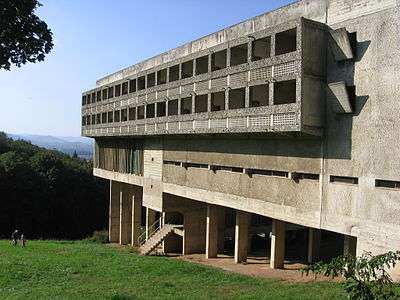Sainte Marie de La Tourette
| Convent Sainte-Marie de La Tourette | |
|---|---|
 | |
| General information | |
| Type | Convent |
| Architectural style | Modernist, International |
| Town or city | Éveux, Rhône-Alpes |
| Country | France |
| Construction started | 1956 |
| Completed | 1960 |
| Renovated | 1981 |
| Design and construction | |
| Architect | Le Corbusier |
| Website | |
| http://www.couventlatourette.com/ | |
| Official name | The Architectural Work of Le Corbusier, an Outstanding Contribution to the Modern Movement |
| Type | Cultural |
| Criteria | i, ii, vi |
| Designated | 2016 (40th session) |
| Reference no. | 1321-015 |
| State Party | France |
Sainte Marie de La Tourette is a Dominican Order priory, located on a hillside near Lyon, France designed by the architect Le Corbusier, the architect’s final and most important building. The design of the building begun in May 1953 and completed in 1961. The committee that decided the creation of the building, considered that the primary duty of the monastery should be the spiritual awakening of the people and in particular the inhabitants of nearby areas. That's why the monastery was placed in Eveux-sur-Arbresle, which is just 25 km from Lyon and is accessible by train or car.
In July 2016, the building and several other works by Le Corbusier were inscribed as UNESCO World Heritage Sites.[1]
Architecture
Exterior:
The monastery consists of four perimeter heavy rectangular structures that create a closed interior space. The one volume that is compact and rests on the edge of the hill houses the church and the church sacrifice, while the other three wings that are created are raised with pilotis of many different shapes and accommodating living spaces and all the rest functions of the monastery.
Interior:
The monastery was designed to have one hundred bedrooms for apprentices and teachers, study rooms, one workplace and one entertainment room, a dining room, a library and a church. At the lowest level are the dining room and the peristyle of the temple in the form of a cross, that functions as ramp and leads to the church. The study, work, entertainment and library halls are placed on the above level, while the monks' cells are at the highest level. Between the four wings surrounding the monastery, an enclosure is created space.
Patio:
The open space between the four wings isn’t a typical patio. It is divided into four parts by the two vertical corridors joining each other. Forms of different geometry are contained in each of the four parts that are created: a cylinder in the inside is a helix staircase, a prismatic roof, a quadrangular pyramid and a series of polygonal apertures on the roof of a parallelepiped protrusion on church’s wall.
Materials:
The structural form of the building is reinforced concrete, with undulating glass surfaces located on three of the four exterior faces, which were designed by Iannis Xenakis.
The use of the light:
The gradual path from the natural landscape to the interior of the sanctuary, where there is no iconographic representation rather than the view of natural light, is at the same time a continuous removal of the visual phenomena from "out" to "in". The complexity of the landscape is reduced to simple geometric shapes and at the end to the ultimate light.
Light is a way of experiencing the space, as it moves freely within it luring the visitor to do the same. In order to control the amount of light that enters the large public spaces and the long corridors, were used vertical, wavy glass sheets.
Now:
Though still functioning for a reduced population of friars, La Tourette has, like Ronchamp, become something of a pilgrimage site for students of architecture. The priory allows overnight stays in the unused cells. Fees for the room go to maintenance of the priory.
Notes
- ↑ "The Architectural Work of Le Corbusier". UNESCO World Heritage Centre. United Nations Educational, Scientific and Cultural Organization. Retrieved 19 July 2016.
References
- Peponis, Ioannis (1997). Landscapes, "The Architectural Design of Meaning". Aleksandia. ISBN 9789602211182.
- Boesiger, Willy, ed. (1996). Le Corbusier: Complete Works (8 volumes). Cambridge, Mass: Birkhauser. ISBN 3-7643-5515-8.
- Curtis, William J R (1986). Le Corbusier: Ideas and Forms. Oxford: Phaidon. ISBN 0-7148-2387-2.
- Gans, Deborah (1987). The Le Corbusier Guide. Princeton: Princeton Architectural Press. ISBN 0-910413-23-1.
- Hoffmann, Peter. "Xenakis, Iannis". Grove Music Online. Oxford Music Online. Retrieved 14 January 2010.
- Potié, Philippe (2001). Le Corbusier:Le Couvent Sainte Marie da la Tourette. Basel, Switzerland: Birkhauser. ISBN 3-7643-6298-7.
External links
| Wikimedia Commons has media related to Couvent Sainte-Marie de La Tourette. |
- Couvent de la Tourette website
- La Tourette at "Great Buildings Online"
- La Tourette at Arcspace.com
- Staying at La Tourette: travel review
Coordinates: 45°49′10″N 4°37′21″E / 45.81944°N 4.62250°E
- High-resolution 360° Panoramas of Sainte Marie de La Tourette | Art Atlas